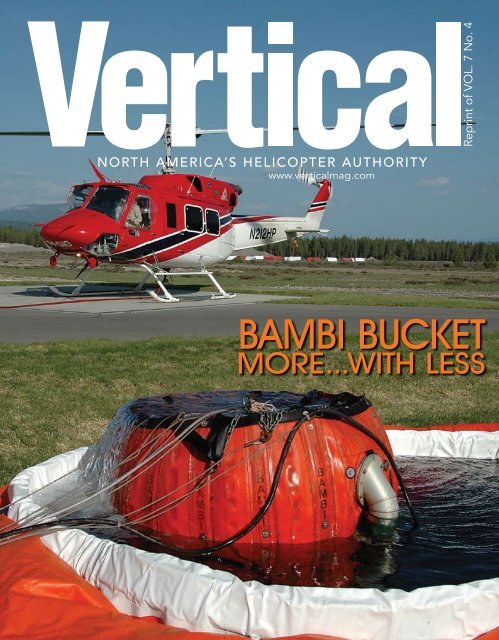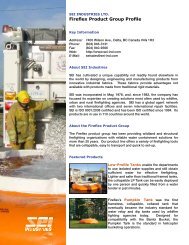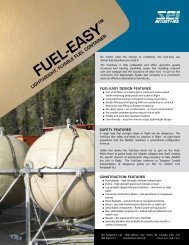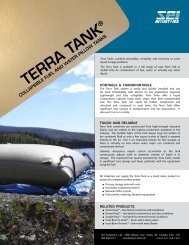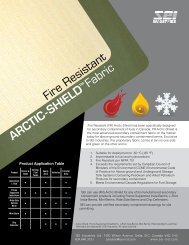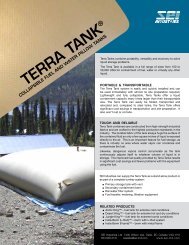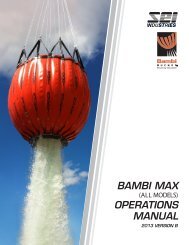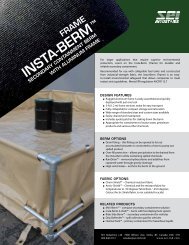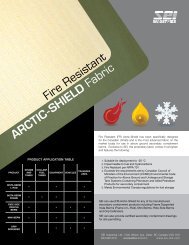Vertical Magazine Features the Bambi Bucket - SEI Industries Ltd.
Vertical Magazine Features the Bambi Bucket - SEI Industries Ltd.
Vertical Magazine Features the Bambi Bucket - SEI Industries Ltd.
Create successful ePaper yourself
Turn your PDF publications into a flip-book with our unique Google optimized e-Paper software.
Reprint of VOL. 7 No. 4<br />
North America’s Helicopter Authority<br />
www.verticalmag.com<br />
<strong>Bambi</strong> <strong>Bucket</strong><br />
More...With Less<br />
August/September 2008 1
Download as wallpaper at verticalmag.com/photos<br />
More...<br />
With Less<br />
With wildland fires getting<br />
bigger and more frequent,<br />
and less money available<br />
in agency budgets to fight<br />
<strong>the</strong>m, operators need a tool<br />
to help <strong>the</strong>m do more.<br />
Story and photos by Jon Mayer<br />
With United States Forest Service (USFS) budgets<br />
being cut by nearly 10 percent, and unprecedented fire<br />
seasons becoming commonplace, fire managers are<br />
going to have to find more efficient ways of fighting<br />
fires with fewer resources at <strong>the</strong>ir disposal.<br />
Everyone in <strong>the</strong> industry, whe<strong>the</strong>r directly fighting fires<br />
or not, can already tell you what is needed to fight fire<br />
with a helicopter — a <strong>Bambi</strong> <strong>Bucket</strong>. For 25 years, <strong>the</strong><br />
<strong>Bambi</strong> <strong>Bucket</strong> has remained an essential tool in <strong>the</strong> aerial<br />
fire fighting effort. Day after day, season after season, each<br />
bucket drops thousands of gallons of water, without fail and with<br />
relatively little maintenance required. But, can this stellar device be<br />
improved upon<br />
Addressing <strong>the</strong> Limitations<br />
The <strong>Bambi</strong> <strong>Bucket</strong> was designed by Don Arney to increase <strong>the</strong> accuracy of<br />
water drops and reduce turnaround times for <strong>the</strong> helicopter to reload at <strong>the</strong> nearest<br />
water source. Its one limitation has always been that if <strong>the</strong> pilot wants to maximize<br />
efficiency, he or she must choose a water source of sufficient depth (generally at least<br />
four feet) to fully submerge <strong>the</strong> bucket. O<strong>the</strong>rwise, <strong>the</strong>y will leave <strong>the</strong> dip site with a partial<br />
load. Searching for water sources of this depth can dramatically reduce <strong>the</strong> number of<br />
potential dip sites available, especially when operating in <strong>the</strong> dry western areas of <strong>the</strong> U.S.<br />
Now, what if <strong>the</strong>re was a way to make use of those shallower water sources significantly<br />
closer to <strong>the</strong> fire line Ironically, fixed, belly-mounted tanks hold <strong>the</strong> answer. These tanks<br />
make use of an ingenious snorkel pump that is lowered into any water source, shallow or<br />
deep, and “powerfills” <strong>the</strong> belly tanks.<br />
In 2001, <strong>SEI</strong> <strong>Industries</strong> of Delta, B.C., manufacturer of <strong>the</strong> <strong>Bambi</strong> <strong>Bucket</strong>, adapted this<br />
powerfill technology for its buckets. Not only is <strong>the</strong> option now available on all new buckets,<br />
model 2024 (240 US gallons) and larger, but existing buckets can be retrofitted to accept<br />
this snorkel-filling capability.<br />
<strong>SEI</strong> offers two versions of its PowerFill pump technology. The widely publicized Torrentula<br />
Valve <strong>Bambi</strong> <strong>Bucket</strong> has <strong>the</strong> PowerFill pump incorporated into <strong>the</strong> design of its variable-dump<br />
valve, and is ideal for larger buckets. The smaller, and far-less-known version is <strong>the</strong> <strong>Bambi</strong><br />
PowerFill snorkel. It utilizes a one-way flapper valve built into fabric shell of <strong>the</strong> bucket,<br />
approximately 12 inches below <strong>the</strong> top rim. From this fitting, <strong>SEI</strong> bolted an external snorkel<br />
pump, which draws in water from <strong>the</strong> bottom 12 inches of <strong>the</strong> bucket, and requires as little as<br />
12 to 18 inches of water depth to achieve a completely full bucket.<br />
Real-World Proof<br />
The <strong>Bambi</strong> PowerFill is <strong>the</strong> snorkel my company, Heli-1 Corp of Reno, Nev., has been using for<br />
<strong>the</strong> last three fire seasons on our Bell 212HP with a 240-gallon <strong>Bambi</strong> <strong>Bucket</strong>. Our experience has<br />
been very positive, and in more ways than we could have foreseen.<br />
Everyone’s first reaction, upon seeing <strong>the</strong> pump for <strong>the</strong><br />
first time, is to ask, “What’s that” This is followed by,<br />
“We’re not going to need that around here.” Close on <strong>the</strong><br />
heels are statements that <strong>the</strong> snorkel looks heavier and<br />
bulkier than what <strong>the</strong>y are used to. Granted, <strong>the</strong> sturdy<br />
pump makes <strong>the</strong> standard bucket 45 pounds heavier, but<br />
you can remove <strong>the</strong> bucket’s 20 pounds of lead ballast.<br />
(Lead is no longer needed to keep <strong>the</strong> bucket from spinning<br />
in forward flight as <strong>the</strong> offset mounting of <strong>the</strong> pump now<br />
performs this function.) Twenty-five pounds extra weight<br />
is a small price to pay for <strong>the</strong> efficiency gained.<br />
Once <strong>the</strong> snorkel pump is put to work, though, all skepticism<br />
is quickly put to rest. Even I, who believed in <strong>the</strong><br />
snorkel idea, had no idea just how useful it would be on<br />
practically every fire we worked. It has gotten to <strong>the</strong> point<br />
that our pilots feel like <strong>the</strong>y have one arm tied behind <strong>the</strong>ir<br />
back if <strong>the</strong>y have to use a bucket without <strong>the</strong> pump.<br />
Our first experience putting <strong>the</strong> pump to good use came<br />
on its first assignment in <strong>the</strong> Kaibab National Forest on<br />
<strong>the</strong> north rim of <strong>the</strong> Grand Canyon in 2005. This particular<br />
area of <strong>the</strong> “Arizona Strip” is arid high-desert Pinion and<br />
Juniper trees with little water available. Due to <strong>the</strong> lack<br />
of available water, we were directed to a remote Pumpkin<br />
(<strong>SEI</strong> portable water tank), only to find it was only a third<br />
full, or about 2.5 feet deep. As we now do every time this<br />
happens, we laid <strong>the</strong> bucket on its side in <strong>the</strong> water and<br />
<strong>the</strong>n stood it up. This got it about half full. We <strong>the</strong>n moved<br />
<strong>the</strong> thumb-activated cyclic switch to turn on <strong>the</strong> 425-gallon-a-minute<br />
pump, and it topped off <strong>the</strong> bucket in about<br />
15 seconds. This effectively doubled <strong>the</strong> amount water<br />
delivered to that fire without adding extra flight time<br />
or expense.<br />
Imagine if each time, every helicopter left a pumpkin carrying<br />
10 to 50 percent additional water, on a fleet-wide<br />
basis. That would conservatively translate to millions of<br />
gallons of additional water delivered per season. With <strong>the</strong><br />
extensive use of pumpkins as dip sites for water buckets,<br />
opposite For 25 years, <strong>the</strong> orange-colored <strong>Bambi</strong> <strong>Bucket</strong> has<br />
been an essential tool in fighting forest fires from <strong>the</strong> air.<br />
top right Heli-1 of Reno, Nev., has been using <strong>the</strong> PowerFill<br />
snorkel with a 240-gallon <strong>Bambi</strong> <strong>Bucket</strong> on its B412HP for <strong>the</strong> last<br />
three fire seasons. It has had great success in fighting fires with it,<br />
even outdelivering a Skycrane on one day.<br />
below The <strong>Bambi</strong> PowerFill snorkel can fill almost any size<br />
bucket from shallow water sources. Dan Sweet Photo<br />
this is an area <strong>the</strong> snorkel pump can<br />
consistently pay off. If 10 percent<br />
more water delivered is <strong>the</strong> equivalent<br />
of 10 percent more helicopters in <strong>the</strong><br />
air (at no additional expense), <strong>the</strong>n<br />
<strong>the</strong> <strong>Bambi</strong> PowerFill is truly a force<br />
multiplier that cannot be ignored.<br />
On ano<strong>the</strong>r fire, in Sedona, Ariz., in<br />
2006, with a full pumpkin available,<br />
our Bell 212HP was out-delivering a<br />
Bell 205++ because its 324-gallon<br />
bucket was too large to fully submerge.<br />
It had to leave with a partially<br />
full bucket.<br />
An interesting thought to ponder<br />
is that all <strong>the</strong> assumptions made by<br />
interagency decision-makers for <strong>the</strong>ir<br />
best-value performance calculations<br />
(based on pennies per gallon of water<br />
delivered), are figured on full buckets.<br />
In fact, <strong>the</strong>se numbers are valid only if<br />
everyone flies with <strong>the</strong>ir buckets full<br />
all <strong>the</strong> time. The government assumes<br />
this to be true, but, as we’ve seen, it’s<br />
frequently not <strong>the</strong> case.<br />
One of my favorite stories about <strong>SEI</strong>’s snorkel happened<br />
in 2006 in Grants, N.M. Over <strong>the</strong> radio, a local engine<br />
captain, enroute to <strong>the</strong> fire, radioed our helitack personnel<br />
with <strong>the</strong> message, “Don’t bo<strong>the</strong>r hooking up <strong>the</strong> bucket,<br />
because <strong>the</strong>re is no water around here.” But, he was too<br />
late, and we didn’t know any better. Shortly after his radio<br />
call, our pilot on <strong>the</strong> job, Eddie Thoroughgood, emerged<br />
over <strong>the</strong> fire, dumping his first full bucket of water on <strong>the</strong><br />
flames — in full view of <strong>the</strong> flabbergasted engine captain.<br />
The fire was out shortly <strong>the</strong>reafter… but maybe we should<br />
have just let his crew dig line and throw dirt at it<br />
Just Add a Long Line<br />
When <strong>the</strong> efficiency of <strong>the</strong> snorkel is combined with<br />
a 100-foot (or more) long line to access streams, forest<br />
ponds confined by trees or any o<strong>the</strong>r normally inaccesible<br />
water source, anything “wet” becomes fair game and<br />
maximum efficiency is sure to follow.<br />
This was taken to <strong>the</strong> extreme in Yosemite National Park<br />
in California in 2006 when working a fire at <strong>the</strong> top of El<br />
Capitan. We were able to utilize a creek running on top<br />
of El Cap that was 200 feet from <strong>the</strong> edge of <strong>the</strong> fire line.<br />
With designated dip site for Skycranes a 20-minute turn<br />
away, our Bell 212HP out-delivered a Skycrane that day!<br />
Regarding <strong>the</strong> assignments worked in and around <strong>the</strong><br />
Sierra National Forest in California, Patrick Basch, a USFS<br />
forest aviation officer said this about <strong>the</strong> <strong>Bambi</strong> PowerFill<br />
Day after day, season after season, each bucket drops<br />
thousands of gallons of water, without fail and with<br />
relatively little maintenance required. But, can this stellar<br />
device be improved upon<br />
2 verticalmag.com August/September 2008 3
Company Profile<br />
<strong>SEI</strong> INdustries<br />
TOP RIGHT The right tool for <strong>the</strong><br />
job. It's in areas like this where <strong>the</strong><br />
<strong>Bambi</strong> <strong>Bucket</strong> attached to <strong>the</strong> end of<br />
a 100-foot (plus) long line proves its<br />
worth over tank-equipped helicopters.<br />
Dan Sweet Photo<br />
below The PowerFill snorkel allows<br />
<strong>the</strong> <strong>Bambi</strong> <strong>Bucket</strong> to be fully filled, even<br />
when using partially filled Pumpkins.<br />
snorkel: “This added efficiency enabled<br />
<strong>the</strong> flight crew to fill complete buckets<br />
of water from ponds, streams and<br />
depressions with six inches or more<br />
water depth. Often, this capability<br />
enabled this aircraft to produce more<br />
gallons delivered per hour flight time<br />
by a factor of four compared to like<br />
model aircraft with standard <strong>Bambi</strong><br />
<strong>Bucket</strong> configuration. . . . O<strong>the</strong>r benefits<br />
were reduced exposure to [<strong>the</strong>] public when<br />
water-point options were in close proximity to<br />
<strong>the</strong> incident, in case of national parks or wilderness<br />
areas where aircraft noise and visual effects play on<br />
public concern . . . .”<br />
Because <strong>the</strong> snorkel is always attached to <strong>the</strong> bucket, it<br />
is always ready when needed (which, in my experience,<br />
is conservatively 80 percent of <strong>the</strong> time). The bucket still<br />
operates like o<strong>the</strong>r <strong>Bambi</strong> <strong>Bucket</strong>s when <strong>the</strong> pump is not<br />
needed. And, if <strong>the</strong> pump ever became inoperative,<br />
<strong>the</strong> bucket will still work normally (unlike a fixed tank).<br />
At Heli-1, we have had no experience with failures to this<br />
point, and have not required any unscheduled maintenance<br />
in three full fire seasons of use.<br />
Tanks But No Tanks<br />
Okay, some of you are probably wondering how <strong>the</strong><br />
<strong>Bambi</strong> PowerFill snorkel stacks up to a typical fixed<br />
belly tank.<br />
Fixed tanks excel in both <strong>the</strong> wildland urban interface<br />
and grass and brush fire environments. They are used<br />
primarily for connecting “trail drops” and cooling <strong>the</strong> fire<br />
line down for <strong>the</strong> ground crews. <strong>Bucket</strong>s, on <strong>the</strong> o<strong>the</strong>r<br />
hand, excel in forest/heavy timber and mountainous terrain<br />
environments, concentrating on precision drops to<br />
hot spots, as well as making trail drops.<br />
Heli-1 has a fixed belly tank<br />
as vendor-offered additional<br />
equipment to our exclusive-use<br />
fire contract H-510 in Chester,<br />
Calif. During <strong>the</strong> outbreak of<br />
<strong>the</strong> October 2007 Sou<strong>the</strong>rn<br />
California fires, our belly tank<br />
was requested and supplied.<br />
We found, though, that<br />
once our tank arrived, most<br />
aircraft on scene were already<br />
“tanked.” This made our<br />
longline- and snorkel-equipped<br />
<strong>Bambi</strong> <strong>Bucket</strong> somewhat of<br />
a novelty. That novelty soon<br />
turned into name-requests for<br />
H-510, due to its versatility and<br />
ability to remain well above<br />
<strong>the</strong> fire and not fan <strong>the</strong> flames.<br />
Even though most of <strong>the</strong> tanked<br />
helicopters were hydrant filling,<br />
our turn times were still<br />
quicker, as we were able to<br />
access numerous neighborhood swimming pools.<br />
Once <strong>the</strong> Santa Ana event subsided and fires were under<br />
control, mop-up operations began, with precision drops on<br />
hot spots <strong>the</strong> order of <strong>the</strong> day. And, even here, tanked helicopters<br />
could not keep up with <strong>the</strong> snorkel/long<br />
line combination.<br />
The <strong>Bambi</strong> PowerFill snorkel also has no downtime to<br />
reconfigure <strong>the</strong> aircraft for long-line/cargo missions. We<br />
have found <strong>the</strong> snorkel will do almost everything <strong>the</strong> fixed<br />
tank can, with <strong>the</strong> ease of deployment of a bucket. The<br />
fixed tank has in fact become a monkey on our back due to<br />
<strong>the</strong> difficulty in transporting, mounting, dismounting and<br />
handling of such a bulky and heavy piece of equipment.<br />
After having used <strong>the</strong> <strong>Bambi</strong> PowerFill snorkel extensively<br />
for three fire seasons throughout <strong>the</strong> western U.S.,<br />
it is my opinion this additional capability, now available<br />
to enhance <strong>the</strong> performance of <strong>the</strong> battle-tested <strong>Bambi</strong><br />
<strong>Bucket</strong>, is a winning combination that cannot be beat. It<br />
is <strong>the</strong> most important (and overlooked) product available<br />
to <strong>the</strong> aerial fire fighting industry since <strong>the</strong> <strong>Bambi</strong> <strong>Bucket</strong><br />
itself first arrived. My only complaint is it’s not available<br />
on buckets smaller than <strong>the</strong> 240-gallon model. It would be<br />
great if high-performance light helicopters, such as our<br />
Bell 206L-4, using buckets ranging in size from 120 to 210<br />
gallons, could also benefit from <strong>the</strong> <strong>Bambi</strong> PowerFill snorkel.<br />
A helicopter pilot for 22 years, Heli-1 president Jon Mayer<br />
has logged over 5,800 accident-free<br />
flight hours and holds an FAA airline<br />
transport pilot license for both helicopters<br />
and airplanes. Jon is also an FAA<br />
airframe & powerplant mechanic, and<br />
can be reached at jon@heli-1.com.<br />
Out in <strong>the</strong><br />
Wilderness<br />
From fire fighting<br />
buckets to environmental<br />
protection, <strong>SEI</strong> has made a<br />
name for itself creating<br />
products that allow<br />
companies to work in and<br />
protect our wildlands.<br />
Story by Mike Reyno<br />
Photos by Graham Lavery<br />
When <strong>the</strong> <strong>Bambi</strong> <strong>Bucket</strong> went into production 25 years ago,<br />
its inventor, <strong>SEI</strong> <strong>Industries</strong> founder Don Arney, couldn’t have<br />
foreseen <strong>the</strong> big orange bucket would become synonymous<br />
with helicopter fire fighting worldwide.<br />
In fact, it was <strong>the</strong> <strong>Bambi</strong> <strong>Bucket</strong> that kick-started <strong>SEI</strong>, based<br />
in Delta, B.C., into <strong>the</strong> design, manufacturing, marketing and<br />
commissioning of structural-engineered fabric products. These<br />
product lines are not only popular in <strong>the</strong> aviation industry, but<br />
cover <strong>the</strong> remote site logistics supply, environmental and fire<br />
fighting industries.<br />
A tour through <strong>the</strong> company’s 60,000-square-foot manufacturing<br />
facility gives you a better indication of just how <strong>SEI</strong> is utilizing<br />
its engineered fabrics, and a lot of technology, to develop<br />
a variety of unique products. Currently, <strong>the</strong> company has in<br />
place new computerized laser cutters (each bucket used to be<br />
cut by hand); electronic radio-frequency welding equipment for<br />
industrial coated fabrics; metal welding, sewing and machining<br />
equipment; an in-house fabrics testing laboratory; an 11,000<br />
Cdn gallon (13,200 US gallon) test tank with crane; and inhouse<br />
computer systems. But, it all began with just one idea.<br />
The Original <strong>Bucket</strong><br />
Folklore will have you believe <strong>the</strong> bucket got its name from<br />
a sultry waitress named <strong>Bambi</strong>e, who worked at a famous<br />
firefighter bar in Boise, Idaho. In fact, Arney originally planned<br />
to call it <strong>the</strong> <strong>SEI</strong>-Flex, and <strong>the</strong> real, though less exciting, story<br />
opposite It was <strong>the</strong> <strong>Bambi</strong> <strong>Bucket</strong> that kick-started <strong>SEI</strong> into structuralengineered<br />
fabric products.<br />
4 verticalmag.com August/September 2008 5
Company Profile<br />
<strong>SEI</strong> INdustries<br />
came out in an interview with a B.C. university magazine<br />
in 2003: “He [CBC’s Bob Fortune] interviewed me on a<br />
show about inventors and we became friends. One night<br />
over dinner, he asked me what I was going to call it. I<br />
didn’t want to talk business, so I said, ‘The <strong>Bambi</strong> <strong>Bucket</strong>’<br />
— I was just being goofy. But he said it was a great name<br />
and he was relentless in pushing me to keep it.”<br />
Back <strong>the</strong>n, fire fighting buckets were nothing new, but<br />
what Arney was able to perfect that o<strong>the</strong>rs couldn’t was<br />
a valve to deliver a concentrated column of water. Today,<br />
despite <strong>the</strong> onslaught of new competition, <strong>SEI</strong> still controls<br />
over 90 percent of <strong>the</strong> fire fighting bucket market.<br />
Since <strong>the</strong> <strong>Bambi</strong> <strong>Bucket</strong> was first introduced in 1983,<br />
not much has changed to <strong>the</strong> water-carrying vessel itself.<br />
“We still have customers sending us in <strong>the</strong>ir 20 year-old<br />
burgundy-colored fabric buckets for repairs,” said Shawn<br />
Be<strong>the</strong>l, manager of <strong>SEI</strong>’s fire fighting division. “All we typically<br />
have to do is change a few components and <strong>the</strong>se old<br />
<strong>Bambi</strong>es are fire ready!”<br />
Be<strong>the</strong>l joined <strong>SEI</strong> in December 2007, after 22 years<br />
with B.C. Ministry of Forests and Range Fire Protection<br />
Program, including 12 years in its rappel program. He was<br />
also a provincial fire control officer, and worked on incident<br />
management teams. “I guess you can say that I know<br />
<strong>the</strong> <strong>Bambi</strong> <strong>Bucket</strong> well,” he quipped. “The bucket has been<br />
around for so long — people know it, and <strong>the</strong>y know what<br />
<strong>the</strong>y are getting when <strong>the</strong>y order a <strong>Bambi</strong> <strong>Bucket</strong>. It’s a<br />
well-proven product.”<br />
An Expanding Line<br />
Available in over 20 different sizes ranging from its smallest<br />
BB6072 72 US gallon (270 liter) bucket, to <strong>the</strong> HL9800<br />
2,600 gallon (9,840 liter) version, <strong>SEI</strong> sells about 400 buckets<br />
a year. The company has also added 12 options that<br />
can be added to its bucket line, which, said Be<strong>the</strong>l, ranges<br />
from “<strong>the</strong> variable-drop Aqualanche valve, PowerFill snorkel<br />
and PowerFill Torrentula, to Sacksafoam foam injection,<br />
FireSock, Mission Tracker and Remote Load Control.”<br />
<strong>SEI</strong> continues to look at new accessories, options and<br />
capabilities, including its latest offering, <strong>the</strong> Mission<br />
Tracker. (A beta version of <strong>the</strong> product was launched at<br />
Heli-Expo 2008 in Houston, Texas, with a hard launch<br />
scheduled for this fall.) The Mission Tracker has features<br />
like GPS, data recording, electronic load control and preset<br />
split drops. Said Be<strong>the</strong>l, “Our new Mission Tracker goes<br />
beyond knowing where you’ve been dropping loads. It<br />
will track all types of missions from aerial ignition runs,<br />
infrared scanning, and locations of helipads, fuel caches…<br />
everything you’ve done and where you have been. At <strong>the</strong><br />
end of <strong>the</strong> day, your missions can be simply downloaded<br />
to a memory stick and you can see what you’ve done, all<br />
toward maximizing operational efficiencies.”<br />
O<strong>the</strong>r new capabilities <strong>SEI</strong> is examining include innovations<br />
that improve upon delivery of foam and gel products<br />
in <strong>the</strong> <strong>Bambi</strong> <strong>Bucket</strong> systems for interface fire and community<br />
protection. “We are always working with our customers<br />
and fire control agencies to incorporate <strong>the</strong>ir feedback<br />
toward improving what we are doing and developing new<br />
products to meet <strong>the</strong> demand of <strong>the</strong> industry” said Be<strong>the</strong>l.<br />
The gel bucket, though, might actually have <strong>the</strong> biggest<br />
success in North America. “We really do see gel as <strong>the</strong><br />
new way of fighting fires, because it has much more capability<br />
over foam,” said Be<strong>the</strong>l, explaining that gel acts as<br />
a water enhancer. “When gel dries, it can be re-hydrated,<br />
Above <strong>SEI</strong> recently installed a new<br />
laser cutter for cutting <strong>Bambi</strong> <strong>Bucket</strong>s<br />
in a mere few minutes, versus <strong>the</strong><br />
few hours it used to take to cut <strong>the</strong><br />
material by hand.<br />
below <strong>SEI</strong> manufactures <strong>the</strong> bucket<br />
in 20 different sizes, from 72 US<br />
gallons to 2,600 gallons. It sells<br />
about 400 buckets a year.<br />
Mike Reyno Photo<br />
"Within helicopter circles, <strong>SEI</strong>, which employs about 100<br />
people, is best known for <strong>the</strong> <strong>Bambi</strong> <strong>Bucket</strong>, but it represents<br />
only about half <strong>the</strong> company’s revenues."<br />
top left With new regulations<br />
coming in <strong>the</strong> U.S. and Canada,<br />
<strong>SEI</strong>'s remote site division expects<br />
to see growth in its secondary<br />
containment products.<br />
top right <strong>SEI</strong> is marketing its<br />
Red Dragon aerial ignition device,<br />
and Dragon Eggs, as having an<br />
almost zero failure rate.<br />
above <strong>SEI</strong> sells approximately<br />
400 buckets a year in all sizes.<br />
making your water go fur<strong>the</strong>r. It’s far superior to foam in<br />
many ways and with new technologies meeting or in some<br />
cases exceeding environmental regulations, it has good<br />
potential to be embraced by more agencies in <strong>the</strong> industry.”<br />
Be<strong>the</strong>l acknowledged that <strong>SEI</strong> is exploring o<strong>the</strong>r options,<br />
too, including <strong>the</strong> possibility of a lightweight fixed <strong>Bambi</strong><br />
Tank. Unfortunately, he won’t divulge any more information<br />
than to say <strong>the</strong> company has a close eye on <strong>the</strong> tank<br />
market. In <strong>the</strong> meantime, <strong>SEI</strong>, through its <strong>Bambi</strong> <strong>Bucket</strong><br />
product line, continues to provide its customers with <strong>the</strong>ir<br />
choice of single- or multi-dump buckets and <strong>the</strong> many innovative<br />
options that go with <strong>the</strong>m.<br />
Be<strong>the</strong>l said that one of <strong>the</strong> most sought after add-ons<br />
is <strong>the</strong> PowerFill product. Available both internally in <strong>the</strong><br />
multi-dump valve or as an externally mounted snorkel on<br />
<strong>the</strong> standard valve buckets, PowerFill is retrofittable and<br />
provides bottom-filling capability in shallow water sources<br />
at a rate of 450 gallons US a minute. The technology is<br />
getting gleaming reviews. Said Wayne Coulson, president<br />
and CEO of Coulson Aircrane, "For <strong>the</strong> past three seasons<br />
in Australia, <strong>the</strong> <strong>Bambi</strong> Torrentula <strong>Bucket</strong> with Powerfill<br />
accessory has done an excellent job for us with 100 percent<br />
availability over several hundred hours of operation."<br />
O<strong>the</strong>r new non-bucket related fire fighting products<br />
include <strong>the</strong> Red Dragon aerial ignition device. Controlled<br />
using a remote, <strong>the</strong> Red Dragon uses a variable sevenspeed<br />
te<strong>the</strong>r, which allows it to adjust to <strong>the</strong> dispensing<br />
speed, ra<strong>the</strong>r than having <strong>the</strong> helicopter changing flight to<br />
adjust to <strong>the</strong> machine’s drop rate. This enables dispersal of<br />
<strong>SEI</strong>’s Dragon Eggs in perfect concentration levels according<br />
to <strong>the</strong> terrain.<br />
O<strong>the</strong>r Sectors<br />
Within helicopter circles, <strong>SEI</strong>, which employs about 100<br />
people, is best known for <strong>the</strong> <strong>Bambi</strong> <strong>Bucket</strong>, but it represents<br />
only about half <strong>the</strong> company’s revenues. The remainder<br />
comes from its remote site division. Headed up by<br />
Paul Reichard, this division encompasses four key brands:<br />
Remote Site (liquid logistics); Environmental (primary and<br />
secondary containment of hazardous liquids); FireFlex<br />
(ground fire fighting and water storage equipment); and<br />
Emergency Response (chemical, biological, radiological,<br />
nuclear decontamination).<br />
“Only about 15 percent of our remote site division is<br />
related to helicopters,” said Reichard. However, with<br />
new regulations in <strong>the</strong> United States and Canada, this<br />
is expected to increase. He added, “There are new environmental<br />
regulations that include a requirement for fuel<br />
transfer areas to have secondary containment, which will<br />
be a big issue for fuel handling in remote locations.” The<br />
new regulation has existed in <strong>the</strong> U.S., but has not as of<br />
yet been enforced by <strong>the</strong> Environmental Protection Agency.<br />
Reichard said <strong>SEI</strong> has also recently revamped its helipumps,<br />
which are now small enough to fit into a briefcase,<br />
and has made its sphere-shaped Fuel Easy more durable.<br />
“We’ve also launched our three series of fuel tanks<br />
on <strong>the</strong> ground.” Instead of a standard fuel tank for all<br />
environments, <strong>SEI</strong> is offering a version for each type of<br />
climate: <strong>the</strong> Arctic King, Jungle King and Desert King. Said<br />
Reichard, “We will become <strong>the</strong> leader in extreme climate<br />
fuel storage.”<br />
Having both a fire fighting and remote site/environmental<br />
division with approximately 40 different product lines<br />
combined is a big part of <strong>SEI</strong> <strong>Industries</strong>’ success. The<br />
company reached record sales in 2007, and has continued<br />
to hold its place in <strong>the</strong> market as <strong>the</strong> industry leader for<br />
<strong>the</strong> past 25 years.<br />
6 verticalmag.com August/September 2008 7
S i m p l i c i t y<br />
D i v e r s i t y<br />
Reliability<br />
Toll Free: 1.866.43.BAMBI<br />
E-mail: sales@sei-ind.com<br />
WWW.BAMBIBUCKET.COM<br />
7400 Wilson Avenue<br />
Delta, British Columbia<br />
Canada V4G 1E5<br />
Tel: 1.866.570.FIRE<br />
Suite #3, Beaumont House<br />
Hastings, Christ Church<br />
Barbados<br />
Tel: 1.866.43.BAMBI


